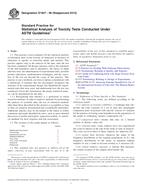Potrebujeme váš súhlas na využitie jednotlivých dát, aby sa vám okrem iného mohli ukazovať informácie týkajúce sa vašich záujmov. Súhlas udelíte kliknutím na tlačidlo „OK“.
ASTM E1970-11
Standard Practice for Statistical Treatment of Thermoanalytical Data
Automaticky preložený názov:
Štandardné praktiky pre štatistické spracovanie dát termoanalytických
NORMA vydaná dňa 1.8.2011
Informácie o norme:
Označenie normy: ASTM E1970-11
Poznámka: NEPLATNÁ
Dátum vydania normy: 1.8.2011
Kód tovaru: NS-43784
Počet strán: 4
Približná hmotnosť: 12 g (0.03 libier)
Krajina: Americká technická norma
Kategória: Technické normy ASTM
Kategórie - podobné normy:
Anotácia textu normy ASTM E1970-11 :
Keywords:
intercept, mean, precision, relative standard deviation, slope, standard deviation, Thermoanalytical data, Intercept, Precision--test methods, Relative standard deviation, Standard deviation, Thermal analysis (TA), ICS Number Code 03.120.30 (Application of statistical methods), 17.200.10 (Heat. Calorimetry)
Doplňujúce informácie
| Significance and Use | ||||||||||||
|
The standard deviation, or one of its derivatives, such as relative standard deviation or pooled standard deviation, derived from this practice, provides an estimate of precision in a measured value. Such results are ordinarily expressed as the mean value ± the standard deviation, that is, X ± s. If the measured values are, in the statistical sense, “normally” distributed about their mean, then the meaning of the standard deviation is that there is a 67 % chance, that is 2 in 3, that a given value will lie within the range of ± one standard deviation of the mean value. Similarly, there is a 95 % chance, that is 19 in 20, that a given value will lie within the range of ± two standard deviations of the mean. The two standard deviation range is sometimes used as a test for outlying measurements. The calculation of precision in the slope and intercept of a line, derived from experimental data, commonly is required in the determination of kinetic parameters, vapor pressure or enthalpy of vaporization. This practice describes how to obtain these and other statistically derived values associated with measurements by thermal analysis. |
||||||||||||
| 1. Scope | ||||||||||||
|
1.1 This practice details the statistical data treatment used in some thermal analysis methods. 1.2 The method describes the commonly encountered statistical tools of the mean, standard derivation, relative standard deviation, pooled standard deviation, pooled relative standard deviation and the best fit to a straight line, all calculations encountered in thermal analysis methods. 1.3 Some thermal analysis methods derive the analytical value from the slope or intercept of a best fit straight line assigned to three or more sets of data pairs. Such methods may require an estimation of the precision in the determined slope or intercept. The determination of this precision is not a common statistical tool. This practice details the process for obtaining such information about precision. 1.4 There are no ISO methods equivalent to this practice. |
||||||||||||
| 2. Referenced Documents | ||||||||||||
|
Podobné normy:
Historická
1.10.2008
Historická
1.3.2013
Historická
1.3.2013
Historická
1.4.2013
Historická
1.6.2012
Historická
1.4.2013
Odporúčame:
Aktualizácia technických noriem
Chcete mať istotu, že používate len platné technické normy?
Ponúkame Vám riešenie, ktoré Vám zaistí mesačný prehľad o aktuálnosti noriem, ktoré používate.
Chcete vedieť viac informácií ? Pozrite sa na túto stránku.



 ASTM E178-08
ASTM E178-08 ASTM E1847-96(2013)..
ASTM E1847-96(2013).. ASTM E1849-96(2013)..
ASTM E1849-96(2013).. ASTM E1994-09(2013)..
ASTM E1994-09(2013).. ASTM E2093-12
ASTM E2093-12 ASTM E2334-09(2013)e..
ASTM E2334-09(2013)e..
 Cookies
Cookies
